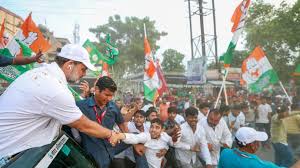Why did Rahul Gandhi’s Bihar Yatra fail to deliver for congress? Here’s is what to know

Why did Rahul Gandhi’s Bihar Yatra fail to deliver for congress? Here’s is what to know
The Bihar assembly elections have delivered a crushing setback for the Congress, leaving Rahul Gandhi’s ambitious Voter Adhikar Yatra largely ineffective. Launched in August 2025, the yatra was designed to highlight alleged “vote theft” by the BJP and the Election Commission. Gandhi had hoped that his outreach would energize voters and recapture the momentum his previous pan-India campaigns had generated.
Spanning 1,300 kilometers, Gandhi’s journey began in Sasaram and concluded in Patna, passing through 25 districts and 110 assembly constituencies. Despite the extensive campaign, preliminary trends suggest Congress is now leading in only four constituencies—Valmiki Nagar, Kishanganj, Manihari, and Begusarai—out of the 61 seats it contested. In contrast, the NDA, with the BJP and JD(U) at the forefront, has secured a commanding lead, with the BJP ahead in 91 seats and JD(U) in 80. Smaller allies such as the Lok Janshakti Party (Ram Vilas), RLM, and HAM also performed well, collectively dominating their contests.
The yatra, which drew inspiration from Gandhi’s previous Bharat Jodo campaigns, had initially aimed to build grassroots enthusiasm. In prior instances, these efforts had contributed to electoral gains in the 2024 Lok Sabha elections and in Telangana, where Congress successfully formed a government. However, in Bihar, Gandhi’s influence appears to have waned, with his “vote theft” narrative failing to resonate with the electorate.
Political analysts point to several factors for Congress’s poor showing. A lack of cohesion among the Mahagathbandhan constituents created confusion for voters. Congress hesitated to endorse Tejashwi Yadav as the alliance’s chief ministerial candidate, leading to mixed messaging. Additionally, internal rivalries and factionalism among alliance partners diluted the campaign’s impact. While Gandhi’s yatra initially energized party workers, the momentum faded, leaving the party struggling for visibility in the final stages of the election.
Voter turnout in Bihar reached a historic high of 66.91%, the highest since the state’s first elections in 1951. Female voters, in particular, played a crucial role, with a record 71.6% turnout. Analysts suggest that welfare schemes introduced by Nitish Kumar’s JD(U)-BJP government appealed strongly to women, contributing to the NDA’s sweeping performance.
The recent elections also followed a contentious revision of electoral rolls, which removed 4.7 million names from the voter list. Congress alleged that the revision disproportionately affected marginalized communities, particularly Muslims, in an attempt to favor the BJP. Both the BJP and the Election Commission denied these claims.
This election marks a significant moment in Bihar politics, as two regional stalwarts—JD(U) Chief Minister Nitish Kumar and RJD leader Lalu Prasad Yadav—edge toward the twilight of their political careers. Both men have dominated the state’s political landscape for decades, and their involvement has continued to shape alliances and voting behavior.
In summary, Congress’s Bihar performance underscores a sharp decline in Rahul Gandhi’s influence, highlighting organizational weaknesses, alliance discord, and the challenge of translating campaign energy into actual votes. Meanwhile, the BJP-JD(U) alliance appears poised for a decisive victory, with strategic appeals to women voters and robust party machinery ensuring a near-sweep across the state.
FAQ
Q: What was Rahul Gandhi’s Voter Adhikar Yatra?
A: It was a campaign launched by Rahul Gandhi in August 2025 across Bihar to highlight alleged vote manipulation by the BJP and the Election Commission.
Q: How many constituencies did Congress win on the yatra route?
A: Congress is leading in only four out of the 61 seats it contested along the yatra route.
Q: Why did Congress perform poorly in Bihar?
A: Factors include internal alliance conflicts, failure to endorse a clear chief ministerial candidate, and fading campaign momentum.
Q: Which parties performed best in the Bihar elections?
A: The BJP and JD(U) led the NDA sweep, with smaller allies like LJP, RLM, and HAM also securing multiple seats.
Q: Did female voters influence the election outcome?
A: Yes, Bihar recorded the highest female voter turnout in history at 71.6%, significantly benefiting the NDA.

